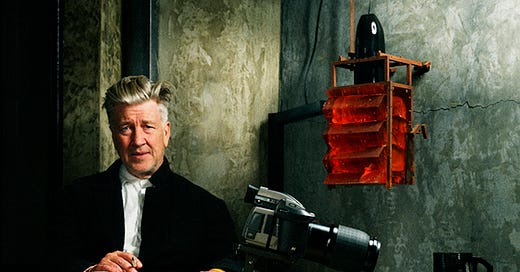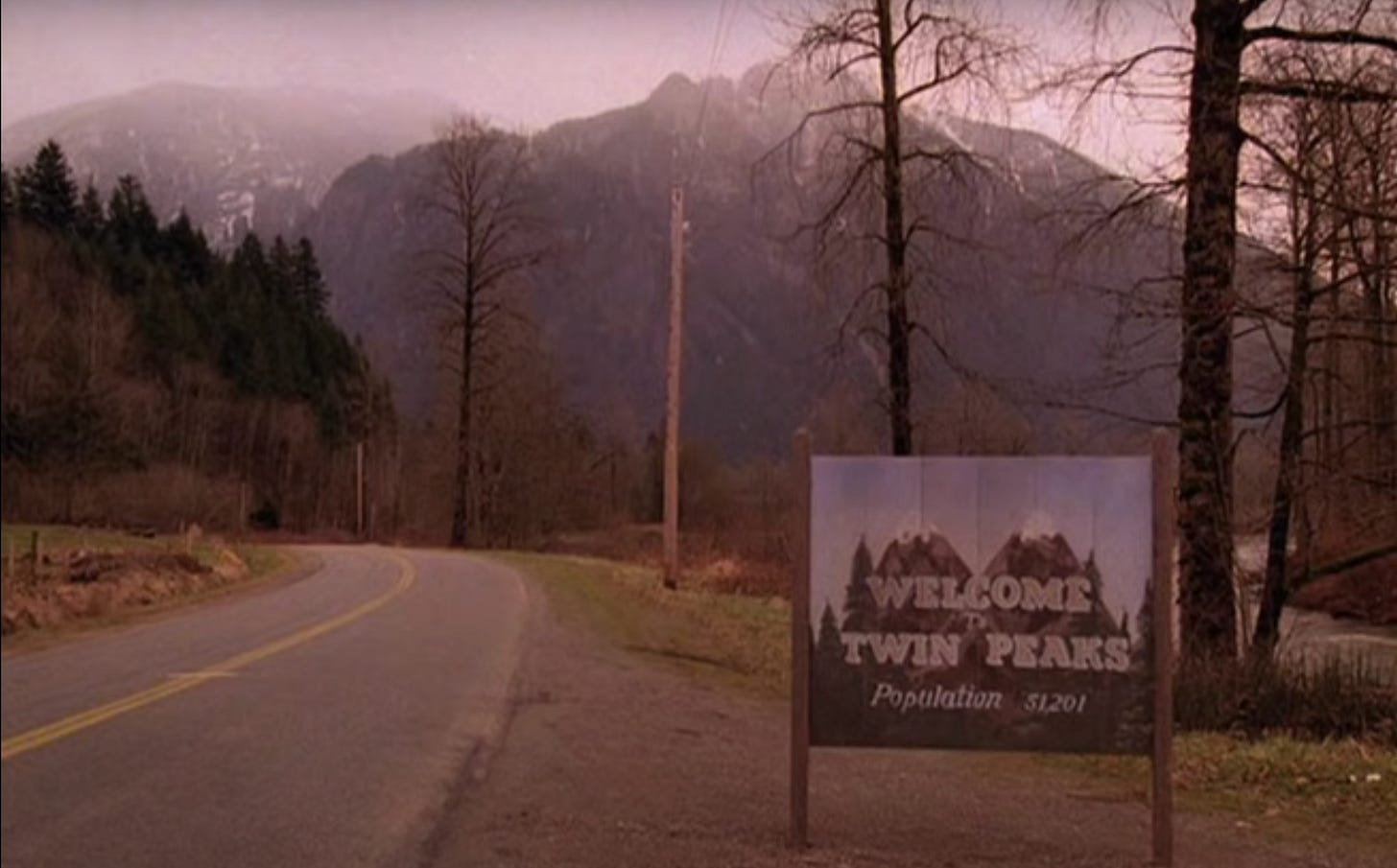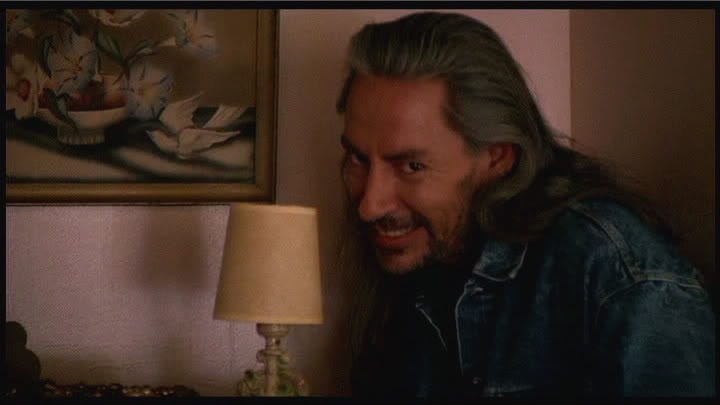Hello film fans,
As you’re no doubt aware, last week we lost one of the true greats: artist, filmmaker, TV revolutioniser, musician, weather reporter and so much more, David Lynch. The outpouring of love and reverence for the man and his work has been quite something, and today we’re laying our own bouquet at the foot of the iconic Twin Peaks sign.
We’re looking back at the TV show that made an entire generation of viewers demand more from their soap operas. We’re also bringing you 10 inimitable moments from Lynch’s career (narrowed down from a longlist in the low thousands), a salute to the auteur’s lo-fi, high-impact VFX and a fresh look at the works that might not seem so quintessentially ‘Lynchian’, but remain essential entries in an oeuvre like no other.
Paying subscribers will be able to enjoy our Lynch tribute in its entirety, plus our regular Wingman quiz. This week it’s on movie buildings, in anticipation of the release of awards magnet The Brutalist - a film we’ll be reviewing in Friday’s edition alongside Presence, Flight Risk and more. In the meantime, have a go on the like and re-stack buttons - and if you’re not a full Wingman member yet, why not sign up for a month’s worth of incisive, independent film writing, all for the cost of a cup of coffee? (After you’ve raised a cup in honour of David, of course). See you Friday.
Matthew (Jordan and Matt)
Peaks Viewing
Looking back on the show that every week, twice a week, gave one Wingman a present…
I first encountered David Lynch in Woolworths. To be more precise, I was in the kids’ books aisle, eyeballing tie-ins for Lynch’s 1984 adap Dune, which I’d heard described as ‘the new Star Wars’. Taking this hype very literally - I was only nine, there was no internet and I believed everything Look-in magazine told me - I eagerly scanned the storybook pages for Wicket and pals, only to be freaked out by all the throbbing blue eyes and the man from The Police in his pants. This was not Star Wars. I decided not to brave the colouring book.
Six years on, I met Lynch again, via the Radio Times. Late October, 1990: a Sherilyn Fenn-fronted cover story on Twin Peaks (‘America’s cult hit comes to BBC2’). Co-created by Lynch and Mark Frost, the show sounded right up my street: American, racy, soapy (I was big into Dallas at the time). Plus, you know, Sherilyn Fenn (I was now 15). Eagerly settling down to watch the feature-length pilot episode on a Tuesday night, I was… a bit baffled and a lot bored. Sure, the scenery was lush (and so were all those donuts), but why did so many of the kids look like they were from the 50s? Was it meant to be a comedy or a thriller? If the latter, why wasn’t it more conventionally thrilling? This was not Dallas.
So thank God for the late-night Saturday repeat. Catching the last third of that, I started to see the (strobe) light. In particular, the cliffhanger, where Laura Palmer’s grieving mum (Grace Zabriskie, possibly the most Lynchian actor of them all) is spooked by a vision, thoroughly spooked me too on second viewing; it left me desperate for another spooking.
A couple of episodes later (and the Saturday repeats - never missed a single one), I was all in. I was - as the RT put it - a ‘Peakie’. I listened on a loop to the spin-off cassette of Agent Cooper’s “Diane…” recordings. I wrote an excessively detailed book report on Jennifer Lynch’s novelisation of Laura’s secret diary for my English GCSE. I drew zigzags on everything.
What a time to be alive, when pop culture was dominated by a barmy show full of non-sequiturs about logs and owls. The theme song got in the top 10 (Julee Cruise on Top of the Pops!); they had ‘Damn Fine Cherry Pie’ on the menu at TGI Friday’s. Peaks-mania soon sank into a trough, but I stayed the course, lovingly synopsizing every episode in my own secret diary (I don’t think I could go back and read those entries now - literally, I mean; my handwriting was as crazed as Killer BOB).
Peaks was my gateway to harder stuff, not least Lynch’s magnificent movies. But I’ll never forget how my horizons were first broadened by that tiny town (population actually 5,120.1 - it’s a network-imposed ‘typo’ on the sign). Those first two seasons gave me a taste for the absurd, the surreal, the wilfully unresolved; I learned that art could make you see and hear and feel things even more uncanny than the Uncanny X-Men. Dune ‘84 couldn’t hold a candle to the Holy Trilogy, but for this obsessed 90s teen, Twin Peaks was the new Star Wars. Thank you for turning me to the dark side, David. (Matthew Leyland)
Lynch Pinned
10 weird and wonderful moments from across David Lynch’s inimitable career
Eraserhead – Chicken dinner
Lynch’s extraordinary debut feature is widely thought to represent his own challenging experience with fatherhood while raising his daughter Jennifer in Philadelphia. But good luck deciphering the unforgettable dinner scene in which Jack Nance’s Henry skewers a tiny, writhing roast chicken only for blighted ooze to spill out. Is it a metaphor for awkward first dinners with the in-laws? A comment on how man has corrupted the natural world? Whatever the case Lynch, famously, never provided answers.
Blue Velvet – In Dreams
A necessary course correction after Dune’s disastrous release, Blue Velvet locates the dark underbelly of the suburban American dream. In one of the film’s most striking sequences Dean Stockwell’s Ben – illuminated by a microphone light – mimes along to Roy Orbison’s ‘In Dreams’ for Dennis Hopper’s depraved Frank, who puts a stop to the performance after getting too emotional. The explosive outburst that follows (“I’ll fuck anything that moves!”) is funny and legitimately frightening.
Twin Peaks – Red Room
You could pick a hundred remarkable moments from the half-dozen Lynch-directed episodes of Twin Peaks, a series that improbably catapulted the master surrealist into mainstream culture. But the iconic Red Room scene which closes out ‘Episode 2’ may be the defining sequence of his career. Almost 20 million people in America tuned in live to watch The Man From Another Place (Michael J. Anderson) deliver cryptic clues (“That gum you like is going to come back in style”) in reverse to an inexplicably aged-up Dale Cooper, before dancing to Angelo Badalamenti’s smooth sax. Like much of Lynch’s work, it’s bizarre and brilliant.
Wild at Heart – Bloody bank robbery
One of the few filmmakers capable of matching Nic Cage’s freak, Lynch adapted Barry Gifford’s novel about lovers on the lam while riffing on The Wizard of Oz and Elvis Presley – totally normal stuff. It’s also explosively violent, particularly in the scene where Willem Dafoe’s Bobby (wearing grotesque fake teeth, face deformed by a stocking over his head) opens fire during a bank robbery, eventually blowing his own head off with a shotgun. The bloody stocking squelching on the ground after is an inspired comedic grace note.
Twin Peaks: Fire Walk With Me – BOB behind the drawers
Once reviled, now revered, Fire Walk With Me is Lynch’s most disturbing and upsetting work. A prequel film about Laura Palmer’s violent final days, perhaps the most effective scene is its most straightforward – Laura enters her family home to find a grinning BOB half-hiding behind a chest of drawers in her bedroom; cue that soul-piercing scream. The destabilising, low-rumble sound design and cut to an endoscopic view of a quivering tonsil amplify the unnerving effect.
Lost Highway – The phone call
Though rarely discussed alongside Carpenter, Craven or Cronenberg, Lynch was almost singularly capable of rendering nightmares on screen. Case in point: Lost Highway’s party scene, which is interrupted by the arrival of Robert Blake’s pale, unblinking Mystery Man. Claiming to be both in front of Bill Pullman’s Fred, and simultaneously inside Fred’s home, the Mystery Man hands over a mobile phone to prove it. It’s sinister enough in itself, but what the Mystery Man represents for Fred is even more horrifying.
Mulholland Drive – Diner scene
Need further proof that Lynch was a gifted horror filmmaker? Mulholland Drive’s diner sequence is up there with cinema’s scariest scenes, and it unfolds in the blistering sun. At Winkie’s Diner – a recurring location throughout the LA story – a man (Patrick Fischler) recounts his nightmare about someone lurking behind the dumpsters out back. Bonnie Aaron’s split-second appearance as the filth-encrusted Bum is enough to scare the man – and many a viewer – to death.
Welcome to the Third Space – PlayStation 2 advert
Lynch has 109 directing credits to his name on IMDb, and barely 10% of those are feature film or TV directing credits. The rest are primarily shorts, music videos and ads – including Welcome To The Third Space, a 2000 promo made for the release of the PlayStation 2. The surrealist vision featuring floating heads, disembodied arms and talking duck men shares a lot in common with concepts later used in Twin Peaks: The Return, but what it all has to do with PlayStation we’ve still no clue.
Inland Empire – Laura Dern FYC ‘campaign’
Inland Empire, Lynch’s reunion with Laura Dern about an actress who loses her mind during a troubled film production, is one of his more challenging feature films; it was shot on low-resolution digital video and with experimental leanings in keeping with his shorts. Lynch was so impressed by Dern’s committed performance that he mounted a one-man campaign to get her nominated for an Academy Award by sitting on a street corner in Hollywood next to a ‘For Your Consideration’ poster and a cow called Georgia. Dern wasn’t nominated, but the campaign did gift us an iconic shot of the loyal filmmaker.
Twin Peaks: The Return – Episode 8
An almost standalone chapter about the origin of evil in the world of Twin Peaks, and America at large, The Return’s extraordinary eighth episode is justifiably considered one of the greatest hours of TV ever. Shot in black and white and largely dialogue-free it jumps back to New Mexico in 1945, where the detonation of the first atomic bomb births the ‘Woodsmen’, who spread their malevolence around the state(s). An episode so good that most forget it opens with a five-minute performance by actual Nine Inch Nails. (Jordan Farley)
Keep reading with a 7-day free trial
Subscribe to The Movie Wingman to keep reading this post and get 7 days of free access to the full post archives.










